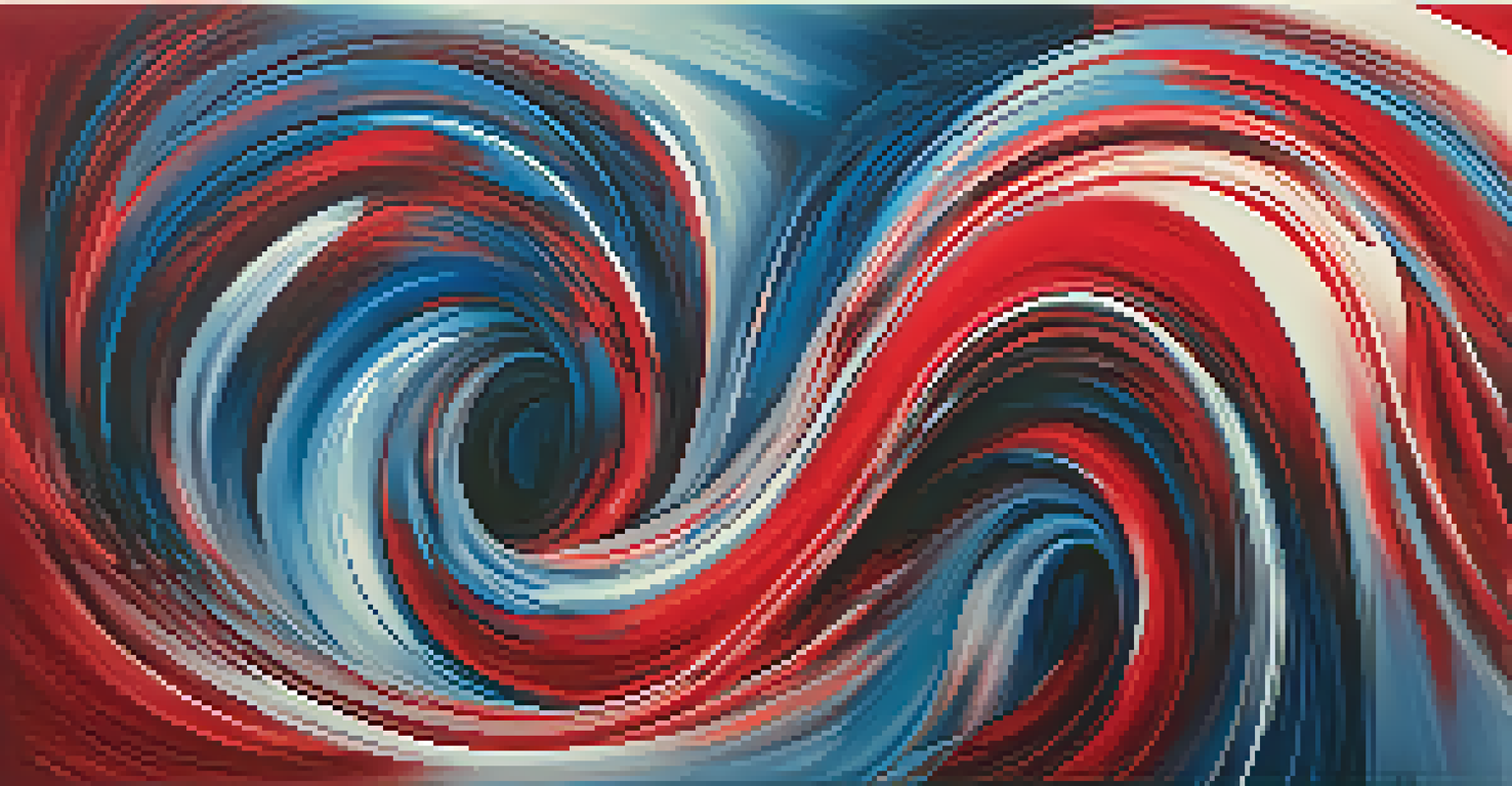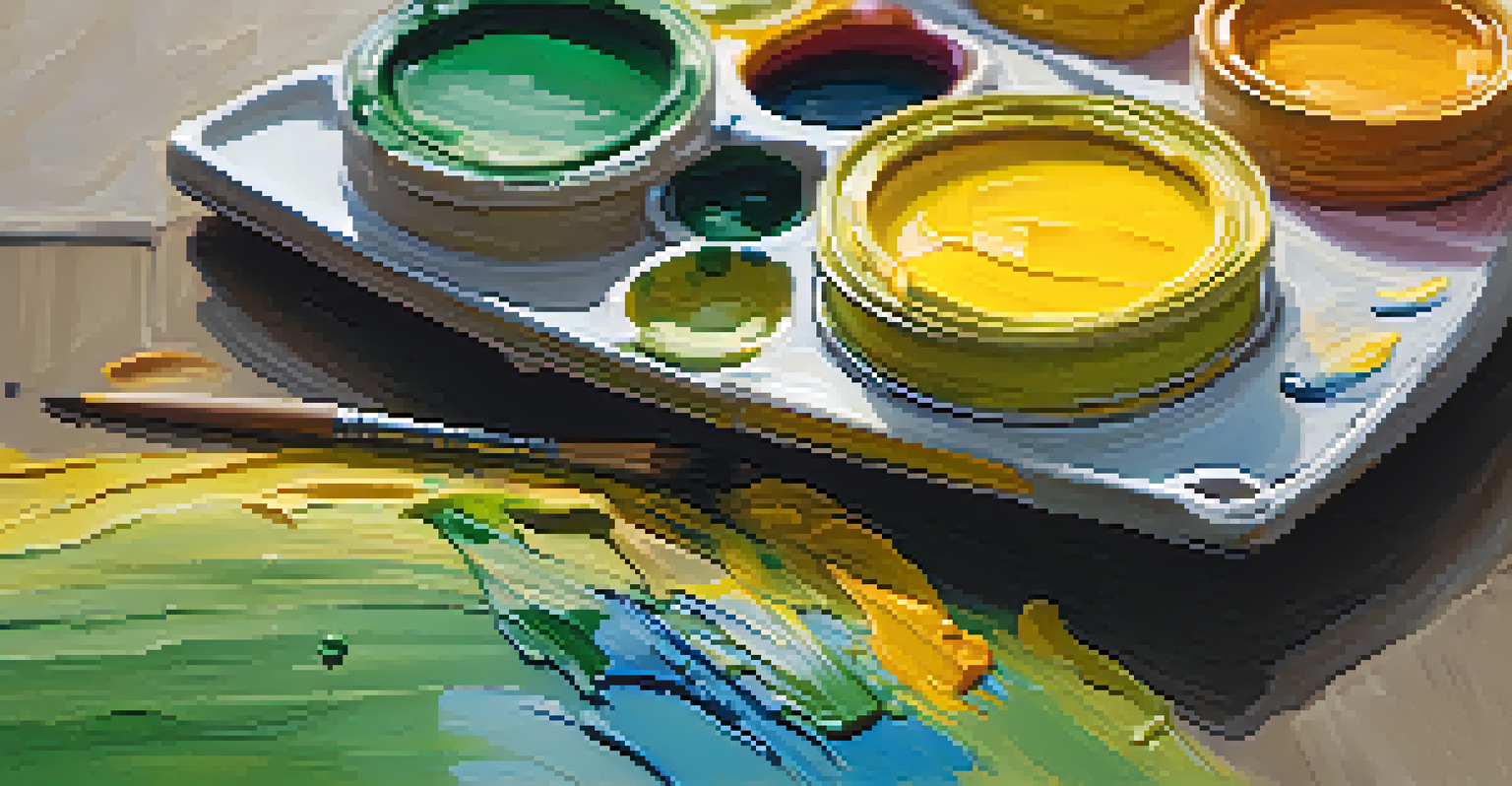Color Psychology in Art and Its Effect on Emotional Awareness

Understanding Color Psychology: A Brief Overview
Color psychology examines how colors affect human behavior and emotions. Each hue can evoke specific feelings, creating a powerful connection between art and the viewer's emotional state. For example, warm colors like red and orange often evoke feelings of warmth and excitement, while cool colors like blue and green can promote calmness and tranquility.
Colors, like features, follow the changes of the emotions.
In art, understanding color psychology is crucial for artists seeking to convey a particular mood or message. Artists can use color strategically to influence how their work is perceived and felt by their audience. This intentional use of color can transform a simple painting into an emotional experience.
Moreover, color can also serve as a form of communication. Just as words convey meaning, colors can express complex emotions and themes without uttering a single word. This makes color a vital tool in the artist's palette, enhancing the overall impact of their work.
The Emotional Spectrum: How Colors Influence Feelings
Different colors resonate with different emotions, shaping our experiences and reactions. For instance, yellow is often associated with happiness and optimism, while black can evoke feelings of sadness or mystery. Understanding this emotional spectrum allows artists to tap into these feelings, crafting pieces that speak to the heart.

Consider Van Gogh's use of vibrant yellows and blues in 'Starry Night.' The contrasting colors create a sense of turmoil and beauty, inviting viewers to feel both joy and melancholy. This interplay of colors not only enhances the visual appeal but also deepens the emotional connection with the audience.
Colors Shape Emotions and Perceptions
Color psychology reveals how different hues can evoke specific feelings and influence human behavior.
Artists can also use color to tell a story or convey a message. For example, the use of red in a painting might symbolize love, passion, or even anger, depending on the context. By skillfully choosing and combining colors, artists can guide viewers on an emotional journey.
Cultural Influences on Color Perception and Meaning
Color perception is not only subjective but also heavily influenced by cultural contexts. In some cultures, white symbolizes purity and innocence, while in others, it may represent mourning and death. Artists must consider these cultural nuances when choosing colors for their artwork to ensure their intended message is understood.
Color is the keyboard, the eyes are the harmonies, the soul is the piano with many strings.
For instance, in Western cultures, red is often associated with love and passion, while in Eastern cultures, it can symbolize good fortune and happiness. This cultural disparity highlights the importance of understanding your audience when creating art that aims to evoke an emotional response.
By recognizing these cultural differences, artists can create more inclusive and relatable works. This not only broadens their audience but also enriches the emotional depth of their art, allowing for a diverse range of interpretations based on personal and cultural experiences.
The Science Behind Color and Emotion: What Research Says
Research in color psychology reveals fascinating insights into how colors affect our emotions and behaviors. Studies have shown that colors can trigger physiological responses, such as changes in heart rate and even blood pressure. For example, red can increase heart rates, while blue tends to have a calming effect.
These scientific findings support the idea that color is not just a visual element but also a psychological one. Artists can leverage this knowledge to create works that elicit specific emotional reactions, making their art more impactful. This intersection of science and creativity enriches the artistic process.
Cultural Context Affects Color Meaning
Cultural backgrounds deeply influence color perception, making it essential for artists to consider their audience.
Moreover, understanding the science of color can help artists design environments that promote certain moods. For instance, a gallery painted in soft pastels may create a soothing atmosphere, enhancing the overall experience of viewing the art on display. This demonstrates how color psychology can play a pivotal role in shaping emotional awareness.
Case Studies: Artists Who Mastered Color Psychology
Throughout history, many artists have skillfully used color psychology to enhance their work. Take Pablo Picasso, for example; during his Blue Period, he used shades of blue to convey feelings of sadness and isolation. This intentional choice of color not only defined a significant phase of his career but also deeply resonated with viewers.
Another example is Mark Rothko, known for his emotive color field paintings. Rothko believed that color should evoke an emotional response, and he achieved this by using large swathes of color that envelop the viewer. His work invites introspection and emotional engagement, demonstrating the power of color in art.
These case studies highlight the profound impact that color can have on emotional awareness. By studying the techniques of these artists, contemporary creators can gain insights into how to effectively use color to communicate emotions and connect with their audience.
Practical Tips for Artists: Using Color to Enhance Emotion
For artists looking to harness the power of color psychology, there are several practical tips to consider. First, experiment with color combinations to see how they affect the overall mood of your artwork. Try contrasting warm and cool colors to create tension or harmony, depending on your desired emotional outcome.
Additionally, think about the emotional response you want to evoke in your audience. Consider the context in which your art will be viewed and how different colors might resonate with viewers. This thoughtful approach can help in crafting pieces that truly connect on an emotional level.
Science Enhances Artistic Expression
Research shows that colors can trigger physiological responses, allowing artists to create emotionally impactful works.
Lastly, don't shy away from researching color theory and psychology. Understanding the fundamentals of how colors interact and their emotional implications can elevate your artistry. By being intentional with your color choices, you can create works that are not only visually stunning but also emotionally compelling.
The Future of Color in Art: Trends and Innovations
As we move into the future, the role of color in art continues to evolve. Emerging technologies, such as digital art and virtual reality, are expanding the possibilities for color usage. Artists can now experiment with colors in ways that were previously unimaginable, enhancing emotional expression.
Moreover, there's a growing trend towards using color as a form of social commentary. Artists are increasingly using color to address issues such as mental health, identity, and cultural representation. This not only brings attention to important topics but also deepens the emotional engagement of their work.

As these trends unfold, the importance of color psychology in art will remain significant. By staying attuned to these innovations and societal changes, artists can continue to use color as a powerful tool for emotional awareness and connection in their work.